Intel Iris Pro 5200 Graphics Review: Core i7-4950HQ Tested
by Anand Lal Shimpi on June 1, 2013 10:01 AM ESTCompute Performance
With Haswell, Intel enables full OpenCL 1.2 support in addition to DirectX 11.1 and OpenGL 4.0. Given the ALU-heavy GPU architecture, I was eager to find out how well Iris Pro did in our compute suite.
As always we'll start with our DirectCompute game example, Civilization V, which uses DirectCompute to decompress textures on the fly. Civ V includes a sub-benchmark that exclusively tests the speed of their texture decompression algorithm by repeatedly decompressing the textures required for one of the game’s leader scenes. While DirectCompute is used in many games, this is one of the only games with a benchmark that can isolate the use of DirectCompute and its resulting performance.
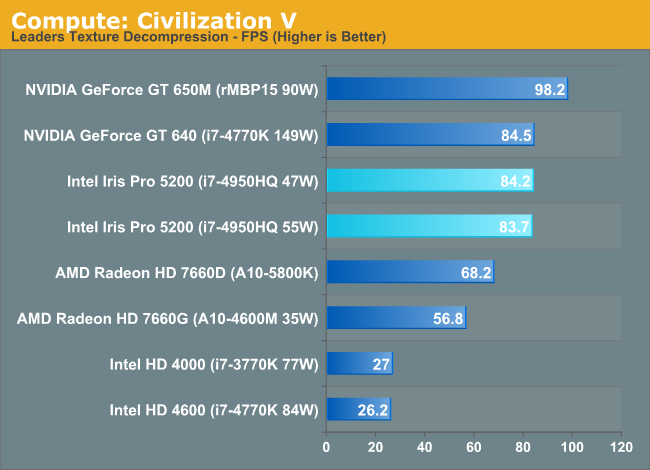
Iris Pro does very well here, tying the GT 640 but losing to the 650M. The latter holds a 16% performance advantage, which I can only assume has to do with memory bandwidth given near identical core/clock configurations between the 650M and GT 640. Crystalwell is clearly doing something though because Intel's HD 4600 is less than 1/3 the performance of Iris Pro 5200 despite having half the execution resources.
Our next benchmark is LuxMark2.0, the official benchmark of SmallLuxGPU 2.0. SmallLuxGPU is an OpenCL accelerated ray tracer that is part of the larger LuxRender suite. Ray tracing has become a stronghold for GPUs in recent years as ray tracing maps well to GPU pipelines, allowing artists to render scenes much more quickly than with CPUs alone.
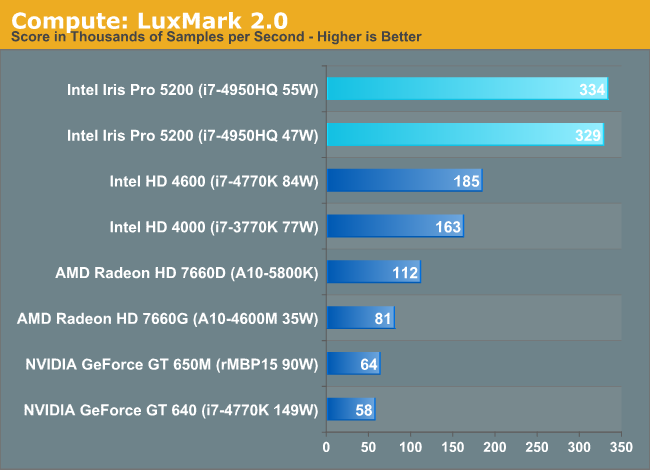
Moving to OpenCL, we see huge gains from Intel. Kepler wasn't NVIDIA's best compute part, but Iris Pro really puts everything else to shame here. We see near perfect scaling from Haswell GT2 to GT3. Crystalwell doesn't appear to be doing much here, it's all in the additional ALUs.
Our 3rd benchmark set comes from CLBenchmark 1.1. CLBenchmark contains a number of subtests; we’re focusing on the most practical of them, the computer vision test and the fluid simulation test. The former being a useful proxy for computer imaging tasks where systems are required to parse images and identify features (e.g. humans), while fluid simulations are common in professional graphics work and games alike.
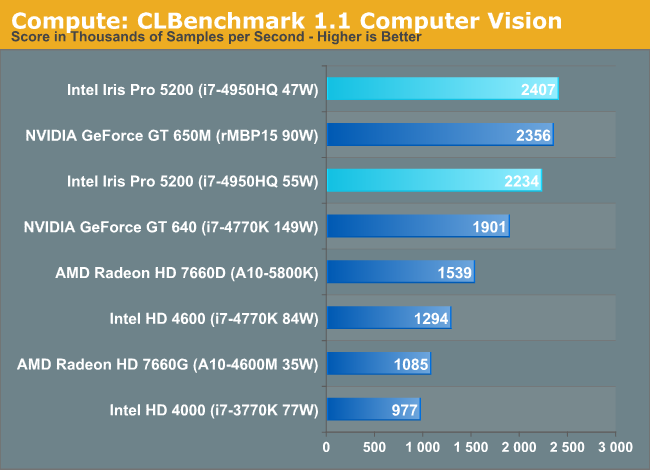
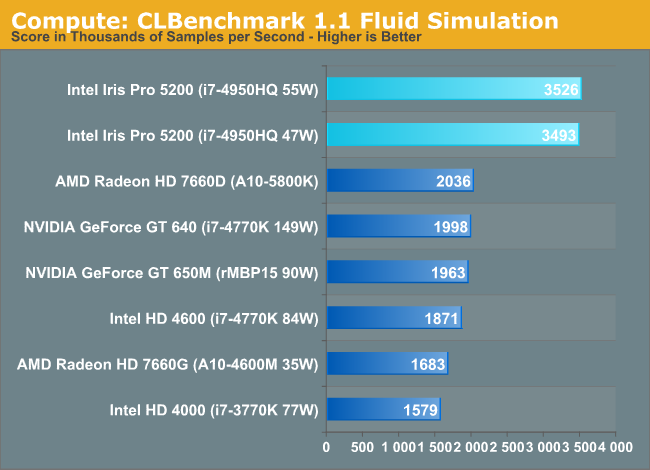
Once again, Iris Pro does a great job here, outpacing everything else by roughly 70% in the Fluid Simulation test.
Our final compute benchmark is Sony Vegas Pro 12, an OpenGL and OpenCL video editing and authoring package. Vegas can use GPUs in a few different ways, the primary uses being to accelerate the video effects and compositing process itself, and in the video encoding step. With video encoding being increasingly offloaded to dedicated DSPs these days we’re focusing on the editing and compositing process, rendering to a low CPU overhead format (XDCAM EX). This specific test comes from Sony, and measures how long it takes to render a video.
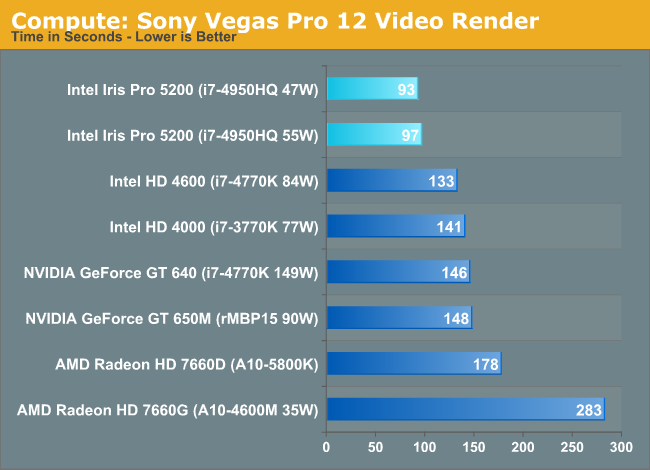
Iris Pro rounds out our compute comparison with another win. In fact, all of the Intel GPU solutions do a good job here.










177 Comments
View All Comments
HisDivineOrder - Saturday, June 1, 2013 - link
I see Razer making an Edge tablet with an Iris-based chip. In fact, it seems built for that idea more than anything else. That or a NUC HTPC run at 720p with no AA ever. You've got superior performance to any console out there right now and it's in a size smaller than an AppleTV.So yeah, the next Razer Edge should include this as an optional way to lower the cost of the whole system. I also think the next Surface Pro should use this. So high end x86-based laptops with Windows 8 Pro.
And NUC/BRIX systems that are so small they don't have room for discrete GPU's.
I imagine some thinner than makes sense ultrathins could also use this to great effect.
All that said, most systems people will be able to afford and use on a regular basis won't be using this chip. I think that's sad, but it's the way it will be until Intel stops trying to use Iris as a bonus for the high end users instead of trying to put discrete GPU's out of business by putting these on every chip they make so people start seeing it CAN do a decent job on its own within its specific limitations.
Right now, no one's going to see that, except those few fringe cases. Strictly speaking, while it might not have matched the 650m (or its successor), it did a decent job with the 640m and that's a lot better than any other IGP by Intel.
Spunjji - Tuesday, June 4, 2013 - link
You confused me here on these points:1) The NUC uses a 17W TDP chip and overheats. We're not going to have Iris in that form factor yet.
2) It would increase the cost of the Edge, not lower it. Same TDP problem too.
Otherwise I agree, this really needs to roll down lower in the food chain to have a serious impact. Hopefully they'll do that with Broadwell used by the GPU when the die area effectively becomes free thanks to the process switch.
whyso - Saturday, June 1, 2013 - link
So intel was right. Iris Pro pretty much matches a 650m at playable settings (30 fps +). Note that anandtech is being full of BullS**t here and comparing it to an OVERCLOCKED 650m from apple. Lets see, when intel made that 'equal to a 650m' claim it was talking about a standard 650m not an overclocked 650m running at 900/2500 (GDDR5) vs the normal 835/1000 (GDDR5 + boost at full, no boost = 735 mhz core). If you look at a standard clocked GDDR3 variant iris pro 5200 and the 650m are pretty much very similar (depending on the games) within around 10%. New Intel drivers should further shorten the gap (given that intel is quite good in compute).JarredWalton - Sunday, June 2, 2013 - link
http://www.anandtech.com/bench/Product/814For the games I tested, the rMBP15 isnt' that much faster in many titles. Iris isn't quite able to match GT 650M, but it's pretty close all things considered.
Spunjji - Tuesday, June 4, 2013 - link
I will believe this about new Intel drivers when I see them. I seriously, genuinely hope they surprise me, though.dbcoopernz - Saturday, June 1, 2013 - link
Are you going to test this system with madVR?Ryan Smith - Sunday, June 2, 2013 - link
We have Ganesh working to answer that question right now.dbcoopernz - Sunday, June 2, 2013 - link
Cool. :)JDG1980 - Saturday, June 1, 2013 - link
I would have liked to see some madVR tests. It seems to me that the particular architecture of this chip - lots of computing power, somewhat less memory bandwidth - would be very well suited to madVR's better processing options. It's been established that difficult features like Jinc scaling (the best quality) are limited by shader performance, not bandwidth.The price is far steeper than I would have expected, but once it inevitably drops a bit, I could see mini-ITX boards with this become a viable solution for high-end, passively-cooled HTPCs.
By the way, did they ever fix the 23.976 fps error that has been there since Clarkdale?
dbcoopernz - Saturday, June 1, 2013 - link
Missing Remote reports that 23.976 timing is much better.http://www.missingremote.com/review/intel-core-i7-...